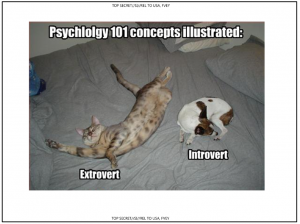Tuesday Morning: Garbage in, Garbage out [UPDATE]
Why’d I pick this music video, besides the fact I like the tune? Oh, no reason at all other than it’s trash day again.
Speaking of trash…
Facebook furor just frothy foam?
I didn’t add yesterday’s Gizmodo piece on Facebook’s news curation yesterday or the earlier May 3 piece because I thought the work was sketchy. Why?
- The entire curation system appears to be contractors — Where is a Facebook employee in this process?
“…News curators aren’t Facebook employees—they’re contractors. One former team member said they received benefits including limited medical insurance, paid time off after 6 months and transit reimbursement, but were otherwise excluded from the culture and perks of working at Facebook. […] When the curators, hired by companies like BCForward and Pro Unlimited (which are then subcontracted through Accenture to provide workers for Facebook), arrive at work each day, they read through a list of trending topics ranked by Facebook’s algorithm from most popular (or most engaged) to least. The curators then determine the news story the terms are related to.
The news curation team writes headlines for each of the topics, along with a three-sentence summary of the news story it’s pegged to, and choose an image or Facebook video to attach to the topic. The news curator also chooses the “most substantive post” to summarize the topic, usually from a news website. […] News curators also have the power to “deactivate” (or blacklist) a trending topic—a power that those we spoke to exercised on a daily basis. …” (emphasis mine)
I see a Facebook-generated algorithm, but no direct employees in the process — only curator-contractors.
- Sources may have a beef with Facebook — This doesn’t sound like a happy work environment, does it?
“…Over time, the work became increasingly demanding, and Facebook’s trending news team started to look more and more like the worst stereotypes of a digital media content farm.
[…]
Burnout was rampant. ‘Most of the original team isn’t there anymore,’ said another former news curator. ‘It was a stop-gap for them. Most of the people were straight out of [journalism school]. At least one of them was fired. Most of them quit or were hired by other news outlets.’ …” (emphasis mine)
It’s not as if unhappy contractors won’t have newsworthy tips, but what about unhappy Facebook employees? Where are they in either of Gizmodo’s pieces?
- Details in the reporting reveal bias in the complainant(s) — So far I see one reference to a conservative curator, not multiple conservative curators.
“Facebook workers routinely suppressed news stories of interest to conservative readers from the social network’s influential “trending” news section, according to a former journalist who worked on the project.
[…]
Other former curators interviewed by Gizmodo denied consciously suppressing conservative news, and we were unable to determine if left-wing news topics or sources were similarly suppressed. The conservative curator described the omissions as a function of his colleagues’ judgements; there is no evidence that Facebook management mandated or was even aware of any political bias at work. …”
Note the use of “a” in front of “former journalist” and “the” in front of “conservative curator.” (Note also Gizmodo apparently needs a spell check app.)
- No named sources confirming the validity of the complaints or other facts in Gizmodo’s reporting — Again, where are Facebook employees? What about feedback from any of the companies supplying contractors; did they not hear complaints from contractors they placed? There aren’t any apparent attempts to contact them to find out, let alone anonymous confirmation from these contract companies. There are updates to the piece yesterday afternoon and this morning, including feedback from Vice President of Search at Facebook, Tom Stocky, which had been posted at Facebook. Something about the lack of direct or detailed feedback to Gizmodo seems off.
- Though named in the first of two articles, Facebook’s managing editor Benjamin Wagner does not appear to have been asked for comment. The May 3 piece quotes an unnamed Facebook spokesperson:
When asked about the trending news team and its future, a Facebook spokesperson said, “We don’t comment on rumor or speculation. As with all contractors, the trending review team contractors are fairly compensated and receive appropriate benefits.”
I’m disappointed that other news outlets picked up Gizmodo’s work without doing much analysis or followup. Reuters, for example, even parrots the same phrasing Gizmodo used, referring to the news curators as “Facebook workers” and not contract employees or contractors. Because of this ridiculous unquestioning regurgitation by outlets generally better than this, I felt compelled to write about my concerns.
And then there’s Gizmodo itself, which made a point of tweeting its report was trending on Facebook. Does Gizmodo have a beef with Facebook, too? Has it been curated out of Facebook’s news feed? Are these two pieces really about Facebook’s laundering of Gizmodo?
I don’t know; I can’t tell you because I don’t use Facebook. Not going to start now because of Gizmodo’s sketchy reporting on Facebook, of all things.
Miscellany
Just some odd bits read because today is as themeless as yesterday — lots of garbage out there.
- SAS Confidential: Unpacking @AcademicsSay, Part 1 (SAS blog) — This is just good fun and yet it’s an incredibly educational collection of insights into the creation of a popular microblog. Worth a read.
- Five Solomon Islands have sunk below sea level (CNN) — This climate change stuff isn’t bullshit. It’s affecting entire cultures with permanent displacement beginning now.
- FCC and FTC want security patches from wireless providers yesterday (CNET) — If not sooner. Maybe these patches would have been done already if these firms hadn’t needed to redirect resources to responding to USDOJ’s encroachment on encryption…
- Amazon’s new Video Direct goes after Google’s YouTube’s user-created videos (Investor’s Business Daily) — Amazon’s throwing out some monetary chum, too, offering to split a monthly pot of $1M among the creators of most popular videos. This could rock indie film distribution.
Skepticism: I haz it
As I read coverage about news reporting and social media leading up to the general election, I also keep in the back of my mind this Bloomberg report, How to Hack an Election:
As for Sepúlveda, his insight was to understand that voters trusted what they thought were spontaneous expressions of real people on social media more than they did experts on television and in newspapers. […] On the question of whether the U.S. presidential campaign is being tampered with, he is unequivocal. “I’m 100 percent sure it is,” he says.
Be more skeptical. See you tomorrow morning!
UPDATE — 1:30 P.M. EDT —
@CNBCnow
JUST IN: Senate Commerce Commtitte chair sends letter to Facebook’s Mark Zuckerberg seeking answers on alleged manipulation of trending news
ARE YOU FUCKING KIDDING ME WITH THIS? THE SENATE GOING TO WASTE TAX DOLLARS ON THIS WHEN EVERY. SINGLE. NEWS. OUTLET. USES EDITORIAL JUDGMENT TO DECIDE WHAT TO COVER AS NEWS?
Cripes, Gizmodo’s poorly sourced hit piece says,
“…In other words, Facebook’s news section operates like a traditional newsroom, reflecting the biases of its workers and the institutional imperatives of the corporation. …”
Yet the Senate is going to pursue this bullshit story after Gizmodo relied on ONE conservative curator-contractor — and their story actually says an algorithm is used?
Jeebus. Yet the Senate will ignore Sheldon Adelson’s acquisition of the biggest newspaper in Las Vegas in a possible attempt to denigrate local judges?
I can’t with this.
UPDATE — 3:35 P.M. EDT —
The Guardian reports the senator wasting our tax dollars questioning a First Amendment exercise by Facebook is John Thune. Hey! Guess who’s running for re-election as South Dakota’s senior senator? Why it’s John Thune! Nothing like using your political office as a free press-generating tool to augment your campaign. I hope Facebook’s algorithm suppresses this manufactured non-news crap.

 Sometime in 2011, I was on a panel with the Democracy Now’s Sharif Kouddous — whose tweeting from Tahrir Square played an important role in keeping the world informed after Hosni Mubarak shut down the Internet. I mentioned that
Sometime in 2011, I was on a panel with the Democracy Now’s Sharif Kouddous — whose tweeting from Tahrir Square played an important role in keeping the world informed after Hosni Mubarak shut down the Internet. I mentioned that 
